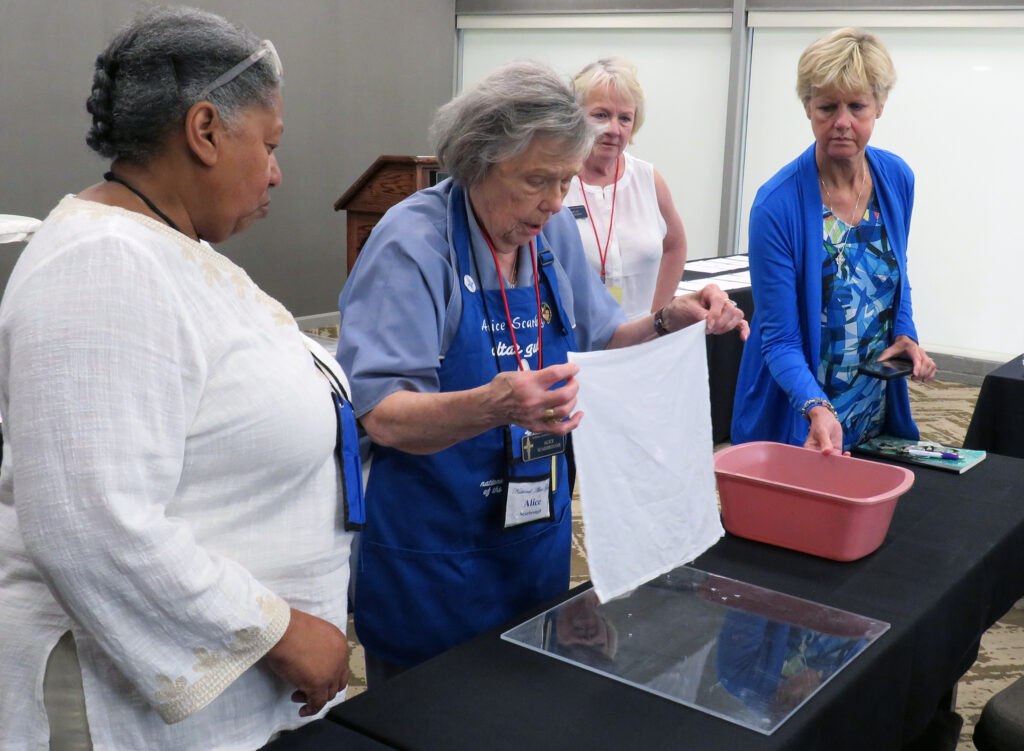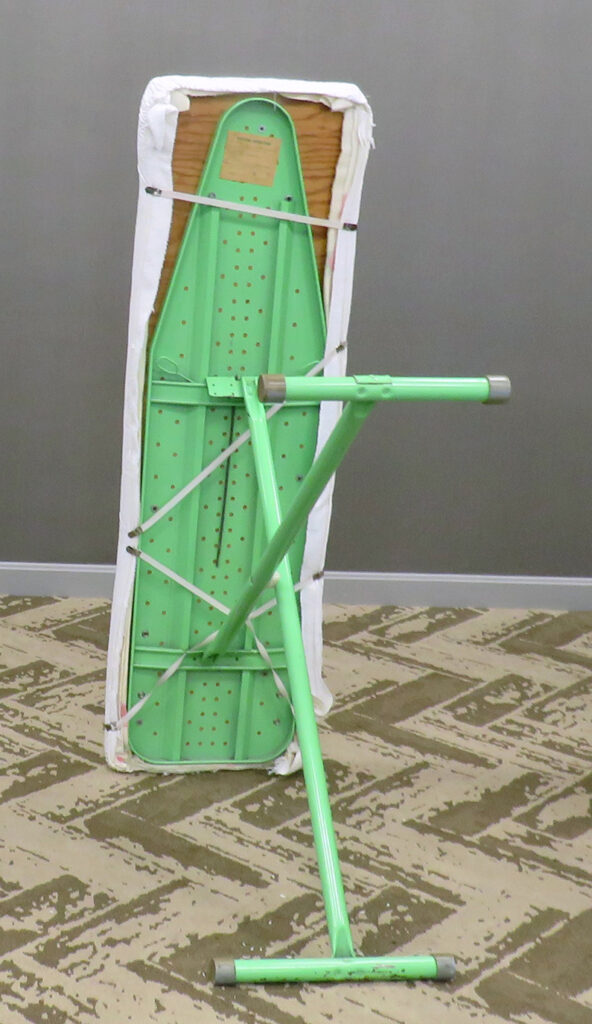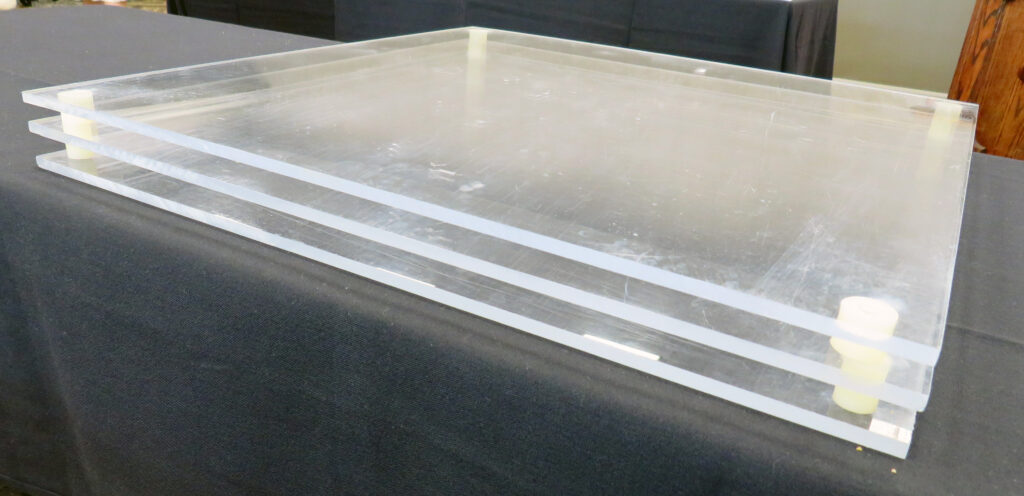Liturgical Threads
The Liturgical Threads workshop was presented by Alice Scarbrough, Diocese of Texas in Austin. Alice is a long time NAGA member and an expert in all aspects of the care of Liturgical fabric items. Her advice was invaluable, and her inventions are amazing.
Have you ever seen an ironing board where the end was squared off to make it easier to iron your larger linens, allowing you to get more of the linen on the ironing board at one time? Alice has one — specially made for her.
Another invention is her plexiglass drying racks for the smaller linens — corporals, lavabo towels, and purificators — making it easier to dry these items where they do NOT need to be ironed. After washing the linens, they are placed on the plexiglass (while very wet) and spread out with the fingers, removing all the air bubbles. Once the linens are dry, they look like they have been ironed and are ready to be folded and used again. The pieces of plexiglass are separated by spacers between each plexiglass piece to allow air between each plexiglass piece. (I already have someone at my church working on making us a set of these plexiglass pieces.) Generally, the linens dry overnight.
Many of my favorite cleaning products were mentioned, but Alice introduced some I had never heard of.
Orvus is a livestock washing product available at tractor supply stores. According to Alice, this product is the best. It should never be used in a washing machine; it is very concentrated so you will only use about 1 to 2 tablespoons in a washing pan or the bathtub. Orvus can remove oily stains, wine, and many other hard-to-remove stains. Orvus can be used on brocade and silk products and rinsed with cold water. Quilters use this product. You must rinse thoroughly after use.
Most of us already use Oxyclean liquid for spot cleaning, and Oxyclean powder is sometimes better for certain stains. You should always use warm water, especially on stains, NOT hot water. I was always taught to hand wash all church linens, but Alice said there is nothing wrong with using the washing machine on gentle cycle. A laundry bag is best for small items.
Many people were interested in the best methods for getting wax out of linens. Alice cautioned that you should always clean out the snuffer; more stains are caused by dirty snuffers than you can imagine. If possible, put linens in the freezer to help peel off the candle wax.
Another product I was not aware of is Naphtha, a paint brush cleaner. This can be poured through fabric to remove wax, followed by using Shout or Oxyclean, and then soaking in Orvus for 2 or 3 days, if traditional methods don’t work.
Orvus and Naphtha are good for removing lipstick. Fels-Naphtha soap is also good. Pears soap is another good product for removing lipstick. Blue Dawn is also good.
Best Press is a spray starch “alternative” that does not leave any residue on your fabric, It’s excellent for ironing linens.
Colgate toothpaste may be just what you need to get stains out. Brush it on with a toothbrush and let it dry. Repeat, if necessary.
“Sunshine, lemon juice, and salt” is another solution for hard-to-remove stains; make a paste of the lemon juice and salt, spread on the stain, and place the item in the sunshine.
Alice recommends stole protectors around the neck of stoles. These can be easily constructed using fabric obtained from JoAnn’s Fabrics. Swiss Baptist Edging is attractive and can also be used to repair various items.
Alice talked about darning brocade; you need the right thread. Barbara Nichols (Province II Representative on the NAGA Board) is a good resource for making repairs to vestments and hangings.
Alice and her church members make baptismal towels from linens that are no longer usable and they give them to all those being baptized.
The Episcopal Book of Common Prayer (BCP) directs that a clean white cloth will be on the altar. All other altar adornments are up to the church, including flowers, except for Palm Sunday. The BCP states that palms will adorn the altar on Palm Sunday.
Alice recommended the following for getting dust, stains, and oil out of kneelers: baking soda or corn meal, sprinkled on the kneelers, and shaken out.
As all altar guild members should know, never use Clorox on linens — it yellows the material and causes holes. Tiny holes can be darned; use fine thread that matches the item. Coates ultra fine is good. Mark the area with a washout pencil. Use fray-check. Do not iron. If it can’t be mended, embroidery over it.
Alice displayed a method for making cording to make or repair a chalice pall using a hand drill, cotton embroidery thread, and a fishing weight.
Finally, Alice talked about her pet project — making stoles for military chaplains. There was an article about this project in the May 2024 NAGA newsletter, Epistle. About 50 of these sets are provided annually to the Bishop of the Armed Forces at the National Cathedral in Washington, DC. Sewers do not need to be members of an altar guild; perhaps someone in your church sews and would like to help with this project. Material and pattern are provided by Alice and each set consists of two stoles, with a different liturgical color on each side of the stoles. To request a kit to make the stoles, please contact Alice at [email protected] or 512-923-3799.
Judy Henderson, Diocese of Central Florida



